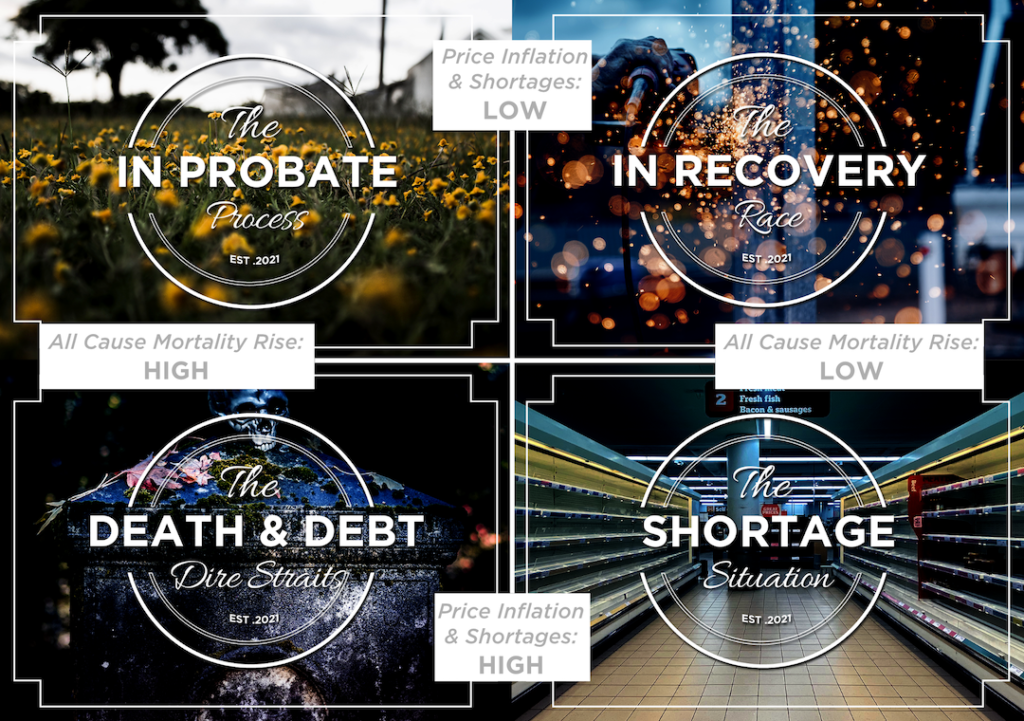
This year, I focused on a shorter time frame than usual in the development of our four scenarios for strategic planning and investment decision-making. Several trends—trends that remain difficult to understand or predict—are reengineering our daily use of time and resources. The result is wide variability in what can happen to our time, resources and health this year.
So, let’s focus on managing the immediate uncertainties before us. Once we see which way the most significant trends are headed, it will become more practical to address a longer time frame with some confidence.
Here are the two variables I chose to generate our four scenarios for 2022.
Variable 1: All-Cause Mortality
This is the big one.
All-cause mortality is a term that describes all of the deaths in a population without regard to what caused them. It is used in clinical trials, sometimes in addition to disease-specific mortality, to determine the impact of a given intervention.
For some time, we have been living with what I often refer to as “The Great Poisoning”—the steady deterioration of health resulting from injections, deterioration in the quality of the food supply, spraying, pesticides, EMF radiation, mind control, and increased political and economic stress, as well as some combination of what amounts to chemical warfare and, possibly, biowarfare. This poisoning accelerated with the Covid-19 injections.
Dr. Mark Skidmore’s survey of Covid impacts in the United States, published in early 2022, estimated a range of 260,000 to 300,000 deaths from the Covid-19 injections so far and 1.1 million potentially life-threatening or life-shortening serious injuries. Numerous experts have predicted significant rates of injection-related immunosuppression that could result in continued high rates of death and disease over a three- to five-year period. As I know from my years of experience as an investment advisor, adverse events and deaths have significant financial impacts on individuals and families.
Because the injections were experimental, and because there are many reasons to believe there was wide variation in the nature of different batches—including regular reports of saline batches—it is impossible to precisely predict what will happen regarding the injections, let alone with future poisonings. However, it is prudent to be prepared for a significant rise in all-cause mortality.
In short, all-cause mortality is our first variable. It can range from low to high, and when it is high, it means the excess mortality is much more than expected.
Variable 2: Price Inflation and Shortages
Price inflation is the increase in the cost of goods. Our focus here is on basic needs, particularly household goods—food, energy, and shelter.
The price of basic household goods has been steadily rising for quite some time and has been much higher than official statistics have let on. However, given the monetary inflation generated through the Going Direct Reset, even greater price inflation is here—and prices could rise dramatically this year.
Price inflation is combined with related shortages, reflecting the dislocations that result from price inflation as well as political efforts to centralize control, impose sanctions, or shut off supply. Whether we call it economic warfare or a breakdown in globalization—or falling productivity as the price of growing organized crime and war—we are confronted with managing shortages that could also greatly intensify this year.
In the current environment, we assume price inflation will go hand in hand with shortages, and together they are our second variable. For our axis, they range from low to high.
Four Scenarios
Laying out our two variables produces four scenarios. Click on the links to read a brief description of each scenario. For planning purposes, think about how you can navigate each one.
Scenario #1: The “In Probate” Process
[High Mortality – Low Inflation/Shortages]
Scenario #2: The “In Recovery” Race
[Low Mortality – Low Inflation/Shortages]
Scenario #3: The “Death & Debt” Dire Straits
[High Mortality – High Inflation/Shortages]
Scenario #4: The “Shortage” Situation
[Low Mortality – High Inflation/Shortages]
